Skip to comments.
The FReeper Foxhole Revisits The Doolittle Raid (4/18/1942) - April 15, 2005
cv6.org ^
Posted on 04/14/2005 9:57:58 PM PDT by snippy_about_it
|

Lord,
Keep our Troops forever in Your care
Give them victory over the enemy...
Grant them a safe and swift return...
Bless those who mourn the lost.
.
FReepers from the Foxhole join in prayer
for all those serving their country at this time.

...................................................................................... ........................................... |
|
|
|
|
|
|
U.S. Military History, Current Events and Veterans Issues
 Where Duty, Honor and Country
Where Duty, Honor and Country
are acknowledged, affirmed and commemorated.
|

| Our Mission: The FReeper Foxhole is dedicated to Veterans of our Nation's military forces and to others who are affected in their relationships with Veterans. In the FReeper Foxhole, Veterans or their family members should feel free to address their specific circumstances or whatever issues concern them in an atmosphere of peace, understanding, brotherhood and support. The FReeper Foxhole hopes to share with it's readers an open forum where we can learn about and discuss military history, military news and other topics of concern or interest to our readers be they Veteran's, Current Duty or anyone interested in what we have to offer. If the Foxhole makes someone appreciate, even a little, what others have sacrificed for us, then it has accomplished one of it's missions. We hope the Foxhole in some small way helps us to remember and honor those who came before us.
To read previous Foxhole threads or
to add the Foxhole to your sidebar,
click on the books below.
|
|
|
|
|
|
The FReeper Foxhole Revisits
The Doolittle Raid
April 18, 1942
In the wake of shock and anger following Pearl Harbor, President Roosevelt pressed his military planners for a strike against Tokyo. Intended as revenge for Pearl Harbor, and an act of defiance in the face of a triumphant Japanese military, such a raid presented acute problems in execution. No working Allied air base was close enough to Japan. A carrier would have to approach within three hundred miles of the home islands for its planes to reach. Sending surface ships so close to Japan at that time would practically assure their destruction, if not from Japan's own surface forces, then from her ground-based planes or submarine forces.
Still Roosevelt insisted - demanded - that a way be found.

The first piece of the puzzle fell into place in the second week of January 1942. Captain Francis Lowe, attached to the Admiral Ernest King's staff in Washington, paid a visit to Norfolk, Virginia, to inspect the new carrier USS Hornet CV-8. There, on a nearby airfield, was painted the outline of a carrier, inspiring Lowe to pursue the possibility of launching ground-based bombers - large planes, with far greater range than carrier-based bombers - from the deck of an aircraft carrier.
By January 16, Lowe's air operations officer, Captain Donald Duncan, had developed a proposal: North American B-25 medium bombers, with capacity for a ton of bombs and capable of flying 2000 miles with additional fuel tanks, could take off in the short distance of a carrier deck, attack Japanese cities, and continue on to land on friendly airfields in mainland China.
Under a heavy veil of secrecy, Duncan and Captain Marc Mitscher, Hornet's commanding officer, tested the concept off the Virginia coast in early February, discovering the B-25s could be airborne in as little as 500 feet of deck space. The plan now began to develop into action.
On April 8, 1942, the same day that the Americans and Filipinos defending Bataan Peninsula surrendered, Enterprise steamed slowly out of Pearl Harbor. With her escorts - the cruisers Salt Lake City and Northampton, four destroyers and a tanker - she turned northwest and set course for a point in the north Pacific, well north of Midway, and squarely on the International Date Line.

Six days earlier, Enterprise's sister ship Hornet had sailed from San Francisco, also accompanied by a cruiser and destroyer screen. Ploughing westwards, Hornet carried a somewhat unusual cargo. Arrayed across her aft flight deck, in two parallel rows, sat 16 Mitchell B-25 bombers: Army Air Force medium bombers. By all appearances, the bombers were too large to possibly take off from a carrier deck.
Certainly, this is what the men in Enterprise's task force thought when Hornet and her escorts hove into view early April 12. Rumors spread about the force's mission: some thought the bombers were being delivered to a base in the Aleutians, while others speculated they were destined for a Russian airfield on the Kamchatka peninsula. When the Task Force Commander, Vice Admiral William F. Halsey, announced "This force is bound for Tokyo" Enterprise rang with a roar of enthusiasm and disbelief.
The plan was more daring than most could imagine. After refueling on April 17, Hornet, Enterprise - the force's Flagship - and four cruisers would leave the destroyers and tankers behind, to make a high speed dash west, towards the Japanese home islands. The next afternoon, Lieutenant Colonel James "Jimmy" Doolittle and his crew would take off alone, arrive over Tokyo at dusk, and drop incendiary bombs, setting fires to guide the remaining bombers to their targets. Three hours behind Doolittle, the remaining fifteen B-25s would be launched, just 500 miles from Tokyo. Navigating in darkness over open ocean, they'd be guided in by Doolittle's blazing incendiaries, and bomb selected military and industrial targets in Tokyo, as well as Osaka, Nagoya and Kobe.

Though the bombers could take off from a carrier deck, they couldn't land on a carrier. Instead of returning to Hornet, they'd escape to the southwest, flying over the Yellow Sea, then some 600 miles into China, to land at the friendly airfield at Chuchow (Zhuzhou). If all went well, the bombers would have a reserve of perhaps 20 minutes of fuel. Success depended on the carriers being able to approach within 500 miles of Japan undetected, and survival on the airmens' ability to evade the formidable air defenses expected near the target areas.
Things went according to plan until early April 18. Shortly after 0300, Enterprise's radar made two surface contacts, just ten miles from the task force. As the force went to general quarters, Halsey turned his ships north to evade the contacts, resuming the course west an hour later. Then, a little past 0600, LT Osborne B. Wiseman of Bombing Six flew low over Enterprise's deck, his radioman dropping a weighted message: a Japanese picket ship had been spotted 42 miles ahead, and Wiseman suspected his own plane had been sighted.
Halsey, however, forged ahead, the carriers and cruisers slamming through heavy seas at 23 knots. Still nearly two hundred miles short of the planned launching point, Halsey strove to give the Army pilots every possible advantage by carrying them as close to Tokyo as he dared.

Ninety minutes later, however, the gig was up. At 0738, Hornet lookouts spotted the masts of another Japanese picket. At the same time, radio operators intercepted broadcasts from the picket reporting the task force's presence. Halsey ordered the cruiser Nashville to dispose of the picket, and launched Doolittle's bombers into the air:
TO COL. DOOLITTLE AND HIS GALLANT COMMAND
GOOD LUCK AND GOD BLESS YOU - HALSEY
|
|
FReeper Foxhole Armed Services Links





TOPICS: VetsCoR
KEYWORDS: b25; carriers; doolittleraid; freeperfoxhole; history; pacific; samsdayoff; tokyo; veterans; wwii
Navigation: use the links below to view more comments.
first 1-20, 21-40, 41-60, 61-80 ... 101-102 next last
.......
Jimmy Doolittle's own bomber was the first to rumble down Hornet's pitching flight deck. Between the forward velocity of the carrier, and the winds churned up by the stormy weather, he and the other pilots had the benefit of a 50 mph headwind. Still, with less than 500 feet of open flight deck to take off from, many of the planes nearly stalled on take-off, and hung precariously over the high seas for hundreds of yards before finally gaining altitude.

As Doolittle's B-25s strained to become airborne, Nashville opened fire on the Japanese picket at a range of 9000 yards, drawing the attention of the Enterprise planes in the area. ENS J. Q. Roberts of Scouting Six made a glide-bombing attack on the little vessel, but missed with his 500-pounder. VF-6 fighters also dove on the picket, then veered off to strafe a second picket even nearer the task force, which had been hidden from view in the wild seas. Over the course of that morning and afternoon, Nashville, Enterprise Air Group, and later planes from Hornet, spotted and attacked sixteen Japanese picket ships. Several were sunk, and more damaged, but the pickets were aided by the high seas, which made them difficult targets.
The last of the sixteen bombers struggled into the air an hour after Doolittle's B-25 cleared Hornet's flight deck. Launched 170 miles further from their targets than planned, the bombers didn't waste fuel forming up, and instead headed directly westward, in a long ragged line behind Doolittle's plane. His mission accomplished, Halsey didn't dally even a minute before ordering Task Force 16 east.

In the afternoon, as the carriers and cruisers raced for safety at 25 knots, radiomen tuned into Radio Tokyo, which was broadcasting a program of English language propaganda. They didn't know it, but also in the listening audience was Ambassador Joseph Grew, interned in the U.S. Embassy in Japan.
A little after 1400 - noon in Tokyo - the announcer's studied English diction suddenly gave way to frantic Japanese, and then dead air. As air raid sirens in Tokyo screamed, Ambassador Grew placed a losing bet with his lunch guest, the Swiss ambassador, wagering the sirens and gunfire were all just a false alarm.
Racing in at just 2000 feet, the first B-25s over Tokyo emptied their bomb bays, and Ambassador Grew's wallet. Doolittle's and twelve other bombers sought out and bombed military and industrial targets throughout Tokyo: an oil tank farm, a steel mill, and several power plants. To the south, other bombers struck targets in Yokohama and Yokosuka, including the new light carrier Ryuho, the damage delaying its launching until November. Perhaps inevitably, some civilian buildings were hit as well: six schools and an army hospital.

Aided by low altitude, camouflage, and extra speed gained from leaving their loads of bombs behind, the bombers were able to evade the enemy fighters patrolling overhead, and anti-aircraft fire from the cities below. But they were far short of the fuel needed to reach the airfield at Chuchow. One plane turned north, and surprised Russian soldiers by landing near Vladivostok. The remaining fifteen planes crashed or were ditched over China. Remarkably, most of the 80 pilots and crewmen survived the mission. Of eight airmen who were captured, three were executed by the Japanese, and another died in captivity. Four others were killed during the mission.
The Consequences
The damage inflicted by Doolittle and his raiders was slight, but it had lasting effects on both sides of the Pacific. As Roosevelt had calculated, the daring raid was a tremendous boost to American morale, which had been severely tested by four long months of defeat and loss.

China bore the heaviest cost of the raid. In May 1942, the Japanese army launched operation Sei-Go, with the dual aims of securing Chinese airfields from which raids could be launched against the Home Islands, and punishing villages which might have sheltered Doolittle's airmen after the Raid. Exact figures are impossible to come by, but tens of thousands - perhaps as many as 250,000 - Chinese civilians were murdered in the Chekiang and Kiangsu provinces.
The raid, however, made a profound impression on the Japanese leadership. For several months, the Japanese high command had been debating its next major move against the Allies. The Navy General Staff, headed by Admiral Osami Nagano, called for a strategy of cutting off America from Australia, by occupying the Fiji Islands, New Caledonia and Samoa. Admiral Isoroku Yamamoto, Commander in Chief of the Combined Fleet, disagreed, arguing that the U.S. Navy - in particular, its carriers - had to be neutralized. This necessitated seizing bases in the Aleutian Islands to the north, and the western tip of the Hawaiian Island chain. From those bases, as well as the bases already held in the Gilbert and Marshall Islands, Japanese long-range bombers could keep the American carriers penned up in Pearl Harbor, perhaps even forcing them to retire clear back to the American west coast.

The Doolittle raid ended the debate. With Japan's military deeply embarrassed by having exposed the Emperor to such danger, and fed up with the harassing American carriers, Yamamoto prevailed. His staff was given the go-ahead to prepare and execute a major operation in the central Pacific. Yamamoto hoped the operation - a complex plan involving a feint to the north, followed by the occupation of several American-held islands - would result in "decisive battle" with the American fleet near a tiny atoll known as Midway.
To: All
............
The sixteen bombers employed on the Doolittle Raid were all B-25B models, third production version of North American Aviation's B-25 "Mitchell" medium bomber design. Delivered in 1941, these aircraft were stripped of some of their defensive guns and given extra fuel tanks to extend their range. Two wooden dowels were placed in each plane's plastic tail cone, simulating extra machine guns that might hopefully persuade enemy fighters to keep their distance. Each B-25 carried four 500-pound bombs on the mission. One bomb was decorated with Japanese medals, donated by Navy Lieutenant Stephen Jurika, who had received them during pre-war naval attaché service and now wished to pointedly return them to a hostile government.

The planes were parked on USS Hornet's flight deck in the order they were to leave. There was no room to rearrange them, and their long, non-folding wings made it impossible to send them below. During the two week's outward passage, planes received regular maintenance and engine testing to ensure they would be ready. The leading bomber, piloted by Lieutenant Colonel Doolittle, had but a few hundred feet of deck run to reach flying speed, but every subsequent one had a little more. Each was helped off a Navy launching officer, who timed the start of each B-25's take-off roll to ensure that it reached the forward end of the flight deck as the ship pitched up in the heavy seas, thus giving extra lift at a critical instant.
 Additional Sources:
Additional Sources: www.history.navy.mil
www.brooksart.com
The FReeper Foxhole Remembers The Doolittle Raid (4/18/1942) - Apr. 18th, 2003
2
posted on
04/14/2005 9:58:25 PM PDT
by
snippy_about_it
(Fall in --> The FReeper Foxhole. America's History. America's Soul.)
To: All
'It (the Doolittle Raid) had three real purposes. One purpose was to give the folks at home the first good news that we'd had in World War II. It caused the Japanese to question their warlords. And from a tactical point of view, it caused the retention of aircraft in Japan for the defense of the home islands when we had no intention of hitting them again, seriously in the near future. Those airplanes would have been much more effective in the South Pacific where the war was going on.

A Navy Captain named Low, conceived the idea of taking Army medium bombers off of a Navy carrier and attacking Japan. The B-25 was selected because it was small, because it had the sufficient range to carry 2,000 lbs. of bombs, 2,000 miles, and because it took off and handled very well. First I found out what B-25 unit had had the most experience and then went to that crew, that organization and called for volunteers and the entire group, including the group commander, volunteered.' -- General James "Jimmy" Doolittle
from an interview done in 1980. |
3
posted on
04/14/2005 9:58:53 PM PDT
by
snippy_about_it
(Fall in --> The FReeper Foxhole. America's History. America's Soul.)
To: ruoflaw; Bombardier; Steelerfan; SafeReturn; Brad's Gramma; AZamericonnie; SZonian; soldierette; ...

"FALL IN" to the FReeper Foxhole!

It's Friday. Good Morning Everyone.
If you want to be added to our ping list, let us know.
If you'd like to drop us a note you can write to:
Wild Bird Center
19721 Hwy 213
Oregon City, OR 97045
4
posted on
04/14/2005 10:00:19 PM PDT
by
snippy_about_it
(Fall in --> The FReeper Foxhole. America's History. America's Soul.)
To: snippy_about_it
I want to take this moment to point out that
when Disney cast Doolittle in their 2001 turkey
"Pearl Harbor," they picked . . . wait for it . . .
Alec Baldwin.
Good grief!
5
posted on
04/14/2005 10:04:06 PM PDT
by
Petronski
(I thank God Almighty for a most remarkable blessing: John Paul the Great.)
To: Petronski
And what a rotten choice that was. GRRRRRRR!
6
posted on
04/14/2005 10:15:17 PM PDT
by
SAMWolf
(Liberal Rule #20 - We must play God because the masses are ignorant.)
To: snippy_about_it
Good Night Snippy
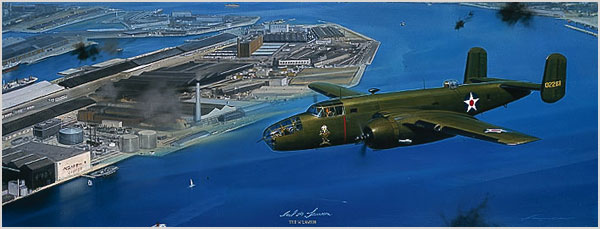
April 18, 1942. Ruptured Duck above Tokyo during the legendary Doolittle raid.
7
posted on
04/14/2005 10:17:12 PM PDT
by
SAMWolf
(Liberal Rule #20 - We must play God because the masses are ignorant.)
To: snippy_about_it
My favorite movie documenting the entire Doolittle Raid was the "Thirty Seconds Over Tokyo" starring Van Johnson, Spencer Tracy, etc. You would see Robert Mitchum in there!
It was really well done movie! I managed to get a VHS copy of it thru eBay!
To: SAMWolf
30 Seconds over Tokyo Bump for the Freeper Foxhole
Regards
alfa6 ;>}
9
posted on
04/14/2005 10:27:51 PM PDT
by
alfa6
To: snippy_about_it
Flying a USAAF medium bomber stripped of defensive armament from a carrier on a one way mission - cajones de brasso. One of the survivors lived in my current city of residence.
10
posted on
04/14/2005 10:30:18 PM PDT
by
Army Air Corps
(I am sick of brownshirts in black robes)
To: snippy_about_it
An early good morning. Snippy you have another fine thread here.



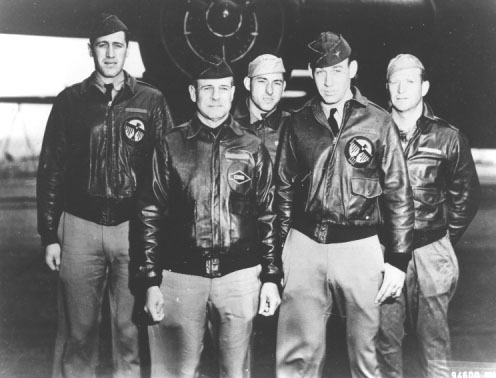
Crew of Plane 1. Henry Potter, James Doolittle, Fred Braemer, Richard Cole, Paul Leonard.
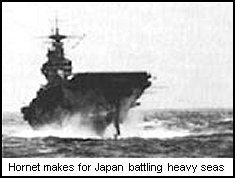
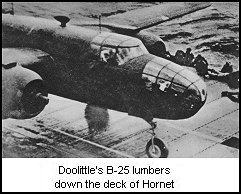
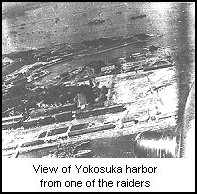







General Marshall; "The President is going to give you the Medal of Honor."
I was shocked and quickly said, "General, that award should be reserved for those who risk their lives trying to save someone else. Every man on our mission took the same risk I did. I don't think I'm entitled to the Medal of Honor."
Hap flushed and I could see he was angry. General Marshall, obviously displeased at my remark, scowled and said, "I happen to think you do."
There was no further discussion. In all our later association, this was the only time Hap ever got mad at me and General Marshall ever spoke sternly to me. The Highest-ranking man Army uniform had made his decision. It was neither the time nor the place for me to argue.
Jimmy Doolittle

In 1985 the 88-year-old legend returned to the White House where he had received the Medal of Honor nearly half-a-century earlier. Under special legislation, pushed through Congress by Senator Barry Goldwater, Jimmy Doolittle received his fourth star. It was the first time any reserve officer achieved 4-star rank. President Ronald Reagan joined Senator Goldwater in pinning that fourth star on General Doolittle.

Four years later Doolittle was back at the White House, this time to be honored by yet another American President. When George H. W. Bush presented the Presidential Medal of Freedom to Jimmy Doolittle, he became the first and to date the ONLY Medal of Honor recipient in history to also earn his Nation's highest civilian honor. Jimmy Doolittle passed away on September 27th, 1993, at the age of 96.


11
posted on
04/14/2005 11:06:27 PM PDT
by
M. Espinola
(Freedom is never free)
To: snippy_about_it; SAMWolf
Good morning, snippy, SAM.
Doolittle's raid 63 years ago is rightly celebrated as the moral turning point of the War in the Pacific, followed by the armed turning point a scant two months later at Midway. It's one of those quirky ironies of history that the former led directly to the latter.
I've been given to understand, on good authority, that many generous toasts were hoisted to Colonel Doolittle (now General Doolittle; may he R.I.P) after V-J Day:*

His role in our Long Road Back was never forgotten by the men who followed in the path he bravely paved through American military history during his "30 seconds over Tokyo."
Thank you, once again, for another excellent thread.
*Post-war pic of my grandfather & grandmother celebrating "V-J Day" along with several of his fellow airmen taken shortly after their return home from active combat.
12
posted on
04/15/2005 12:17:53 AM PDT
by
A Jovial Cad
("I had no shoes and I complained, until I saw a man who had no feet.")
To: snippy_about_it
A negative statement about rear eschelon high brass.
The Doolittle B-25s had their engines recalibrated by the factory's best working with the AAF's best. The aircraft engines were tuned for the altitude flown - good old flight profile, range, load, all the variables. Special parts were fitted. The engines were expected to last for the mission and not a minute longer. All correct.
The men and machines left Florida for Long Beach on schedule, stopping in Texas to refuel. The commander of the base found out about the "unauthorized" modifications, impounded the aircraft and returned them to "authorized" configuration. This delay nearly blew the mission. The senior officer of the flight couldn't get Doolittle on the horn, remember long distance telephone was nearly unknown in 1942. Western Union was all there was.
The aircraft were launched within the preplanned window, but with significantly less range. The crews knew that they did not have enough gas.
Read this story in some newspaper about ten years ago, on April 18th. I think it is true. Doolittle would not waste his men. Evil bastard, that Texas airbase commander.
13
posted on
04/15/2005 1:00:46 AM PDT
by
Iris7
(A man said, "That's heroism." "No, that's Duty," replied Roy Benavides, Medal of Honor.)
To: snippy_about_it; capitan_refugio; fortheDeclaration; Chef Dajuan; mac_truck; Heyworth; ...
14
posted on
04/15/2005 1:48:31 AM PDT
by
M. Espinola
(Freedom is never free)
To: M. Espinola
IMHO, best scene in the film is when they dive the bomber UNDER the Golden Gate Bridge...also, a marvelous score..
15
posted on
04/15/2005 2:40:26 AM PDT
by
ken5050
(The Dem party is as dead as the NHL)
To: snippy_about_it
Good morning, Snippy and everyone at the Foxhole.
16
posted on
04/15/2005 3:06:06 AM PDT
by
E.G.C.
To: ken5050
Ditto on both counts.
At the 1944 Academy Awards, held on March 15th, 1945, 'THIRTY SECONDS OVER TOKYO' won an Oscar for 'Achievement in Special Effects'. The movie was also nominated for 'Achievement in Cinematography'.
Regrettably the film's fine, moving musical score was not even nominated.
17
posted on
04/15/2005 3:21:58 AM PDT
by
M. Espinola
(Freedom is never free)
To: M. Espinola
What we learn from the attack on Tokyo, is how small things can lead to unexpected consquences, the battle of Midway and Japan's first severe naval defeat.
To: snippy_about_it; SAMWolf; All

| April 15, 2005
Those Who Passed By
Those who passed by blasphemed Him. -Mark 15:29
|
 Consider the people who callously passed by the Savior as He hung on the cross. How heartless they were! But before we rush to judge them, let's remember that many are still doing it today. They fall into three groups: Consider the people who callously passed by the Savior as He hung on the cross. How heartless they were! But before we rush to judge them, let's remember that many are still doing it today. They fall into three groups:
Those who want a cross without Christ. It's possible to revere a symbol without the Savior. Some may clasp in their hand a miniature cross made of wood or gold, but that emblem will never atone for even one sin. It is Christ alone who redeems our souls with His precious blood. Those who want a Christ without a cross. They want a conqueror, not a dying Lamb. They would cry, "Come down from the cross!" (Mark 15:30). Many desire a good example, or a great teacher, or a triumphant king. Their gospel is one of works. They despise the gospel that declares we are justified by faith in One who shed His blood on the cross. Those who want neither Christ nor His cross. They are untouched by His sorrow, unmoved by His suffering, and unrepentant of their sins that He bore. Never have they exclaimed as did the songwriter John M. Moore, "All my iniquities on Him were laid-He nailed them all to the tree. Jesus the debt of my sin fully paid-He paid the ransom for me." -Paul Van Gorder
Bearing shame and scoffing rude,
In my place condemned He stood-
Sealed my pardon with His blood:
Hallelujah, what a Savior! -Bliss
© 1953, Singspiration, Inc.
Jesus took our place that we might have His peace.
FOR FURTHER STUDY
Religion Or Christ: What's The Difference?
|
19
posted on
04/15/2005 4:09:32 AM PDT
by
The Mayor
( Blessed is the man who trusts in the Lord, and whose hope is the Lord)
To: fortheDeclaration
The battle of Midway could have gone the other way, but was not meant to. If the Doolittle Raid did not take place Japan would have been able to devote more attention to her Asian conquests as well.
20
posted on
04/15/2005 4:15:50 AM PDT
by
M. Espinola
(Freedom is never free)
Navigation: use the links below to view more comments.
first 1-20, 21-40, 41-60, 61-80 ... 101-102 next last
Disclaimer:
Opinions posted on Free Republic are those of the individual
posters and do not necessarily represent the opinion of Free Republic or its
management. All materials posted herein are protected by copyright law and the
exemption for fair use of copyrighted works.
FreeRepublic.com is powered by software copyright 2000-2008 John Robinson















































